《大学英语翻译》课程PPT教学课件(口译)Module 4 Escort & liaison interpreting(Exercise)
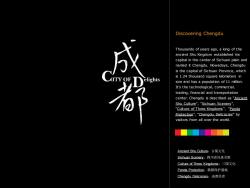
Discovering Chengdu Thousands of years ago,a king of the ancient Shu Kingdom established his capital in the center of Sichuan plain and named it Chengdu.Nowadays,Chengdu is the capital of Sichuan Province,which is 1.24 thousand square kilometers in AITY OF elights size and has a population of 11 million. It's the technological,commercial, trading,financial and transportation center.Chengdu is described as "Ancient Shu Culture”,"Sichuan Scenery”, "Culture of Three Kingdoms","Panda Protection","Chengdu Delicacies"by visitors from all over the world. Ancient Shu Culture:古蜀文化 Sichuan Scenery:四川省风景名胜 Culture of Three Kingdoms:三国文化 Panda Protection:熊猫保护基地 Chengdu Delicacies:成都美食
Discovering Chengdu Thousands of years ago, a king of the ancient Shu Kingdom established his capital in the center of Sichuan plain and named it Chengdu. Nowadays, Chengdu is the capital of Sichuan Province, which is 1.24 thousand square kilometers in size and has a population of 11 million. It’s the technological, commercial, trading, financial and transportation center. Chengdu is described as “Ancient Shu Culture”, “Sichuan Scenery”, “Culture of Three Kingdoms”, “Panda Protection”, “Chengdu Delicacies” by visitors from all over the world. Ancient Shu Culture:古蜀文化 Sichuan Scenery:四川省风景名胜 Culture of Three Kingdoms:三国文化 Panda Protection:熊猫保护基地 Chengdu Delicacies:成都美食
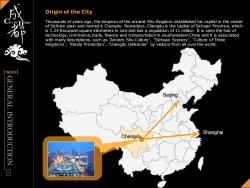
Origin of the City Thousands of years ago,the emperor of the ancient Shu Kingdom established his capital in the center of Sichuan plain and named it Chengdu.Nowadays,Chengdu is the capital of Sichuan Province,which is 1.24 thousand square kilometers in size and has a population of 11 million.It is seen the hub of technology,commerce,trade,finance and transportation in southwestern China and it is associated with many descriptions,such as"Ancient Shu Culture","Sichuan Scenery","Culture of Three Kingdoms","Panda Protection","Chengdu Delicacies"by visitors from all over the world 【INDEX】 GENERAL INTRODUCTION Beijing Shanghai Chengdu
[] INDEX Origin of the City Thousands of years ago, the emperor of the ancient Shu Kingdom established his capital in the center of Sichuan plain and named it Chengdu. Nowadays, Chengdu is the capital of Sichuan Province, which is 1.24 thousand square kilometers in size and has a population of 11 million. It is seen the hub of technology, commerce, trade, finance and transportation in southwestern China and it is associated with many descriptions, such as “Ancient Shu Culture”, “Sichuan Scenery”, “Culture of Three Kingdoms”, “Panda Protection”, “Chengdu Delicacies” by visitors from all over the world. GENERAL INTRODUCTION Chengdu Beijing Shanghai
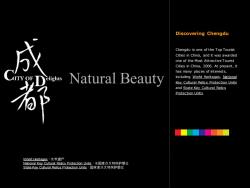
Discovering Chengdu Chengdu is one of the Top Tourist Cities in China,and it was awarded one of the Most Attractive Tourist Cities in China,2006.At present,it has many places of interests, AITY OF Natu ral Beauty including World Heritages,National Key Cultural Relics Protection Units and State Key Cultural Relics Protection Units Vorld Heritages:世界遗产 National Key Cultural Relics Protection Units:全国重点文物保护单位 State Key Cultural Relics Protection Units:国家重点文物保护单位
Discovering Chengdu Chengdu is one of the Top Tourist Cities in China, and it was awarded one of the Most Attractive Tourist Cities in China, 2006. At present, it has many places of interests, including World Heritages, National Key Cultural Relics Protection Units and State Key Cultural Relics Protection Units. Natural Beauty World Heritages:世界遗产 National Key Cultural Relics Protection Units:全国重点文物保护单位 State Key Cultural Relics Protection Units:国家重点文物保护单位
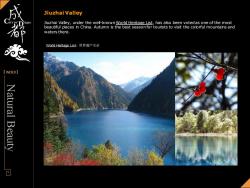
Jiuzhai Valley Jiuzhai Valley,under the well-known World Heritage List,has also been voted as one of the most beautiful places in China.Autumn is the best season for tourists to visit the colorful mountains and waters there. World Heritage List:世界遗产名录 【INDEX) Natural Beauty
[] INDEX Jiuzhai Valley Jiuzhai Valley, under the well-known World Heritage List, has also been voted as one of the most beautiful places in China. Autumn is the best season for tourists to visit the colorful mountains and waters there. Natural Beauty World Heritage List:世界遗产名录
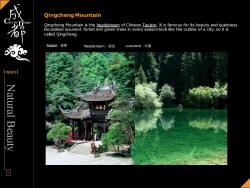
Qingcheng Mountain Qingcheng Mountain is the headstream of Chinese Taoism.It is famous for its beauty and quietness Boundless luxuriant forest and green trees in every season look like the outline of a city,so it is called Qingcheng. Taoism:道家 Headstream:源流 Luxuriant:丰言 【INDEX】 Natural Beauty
[] INDEX Qingcheng Mountain Qingcheng Mountain is the headstream of Chinese Taoism. It is famous for its beauty and quietness. Boundless luxuriant forest and green trees in every season look like the outline of a city, so it is called Qingcheng. Natural Beauty Taoism:道家 Headstream:源流 Luxuriant:丰富
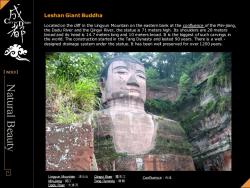
Leshan Giant Buddha Located on the cliff in the Lingyun Mountain on the eastern bank at the confluence of the Min-jiang, the Dadu River and the Qingyi River,the statue is 71 meters high.Its shoulders are 28 meters broad and its head is 14.7 meters long and 10 meters broad.It is the biggest of such carvings in the world.The construction started in the Tang Dynasty and lasted 90 years.There is a well designed drainage system under the statue.It has been well preserved for over 1200 years 【INDEX】 Natural Beauty Lingyun Mountain:凌云山 Qinavi River:青衣江 Confluence:合流 Min-iiang:闵江 Tang Dynasty:唐朝 Dadu River:大渡河
[] INDEX Leshan Giant Buddha Located on the cliff in the Lingyun Mountain on the eastern bank at the confluence of the Min-jiang, the Dadu River and the Qingyi River, the statue is 71 meters high. Its shoulders are 28 meters broad and its head is 14.7 meters long and 10 meters broad. It is the biggest of such carvings in the world. The construction started in the Tang Dynasty and lasted 90 years. There is a well - designed drainage system under the statue. It has been well preserved for over 1200 years. Natural Beauty Lingyun Mountain:凌云山 Qingyi River:青衣江 Min-jiang:闵江 Tang Dynasty:唐朝 Dadu River:大渡河 Confluence:合流
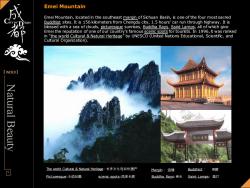
Emei Mountain Emei Mountain,located in the southeast margin of Sichuan Basin,is one of the four most sacred Buddhist sites.It is 156 kilometers from Chengdu city,1.5 hours'car run through highway.It is blessed with a sea of clouds,picturesque sunrises,Buddha Rays,Saint Lamps,all of which give Emei the reputation of one of our country's famous scenic spots for tourists.In 1996,it was ranked in "the world Cultural Natural Heritage"by UNESCO (United Nations Educational,Scientific,and Cultural Organization). 【INDEX】 Natural Beauty he world Cultural&Natural Heritage:世界文化与自然遗产 Margin:边缘 Buddhist: 佛教 Picturesque:生动如画 scenic spots:风景名胜 Buddha Rays:佛光 Saint Lamps:圣灯
[] INDEX Emei Mountain Emei Mountain, located in the southeast margin of Sichuan Basin, is one of the four most sacred Buddhist sites. It is 156 kilometers from Chengdu city, 1.5 hours’ car run through highway. It is blessed with a sea of clouds, picturesque sunrises, Buddha Rays, Saint Lamps, all of which give Emei the reputation of one of our country’s famous scenic spots for tourists. In 1996, it was ranked in “the world Cultural & Natural Heritage” by UNESCO (United Nations Educational, Scientific, and Cultural Organization). Natural Beauty The world Cultural & Natural Heritage:世界文化与自然遗产 Margin: 边缘 Buddhist: 佛教 Picturesque:生动如画 scenic spots:风景名胜 Buddha Rays:佛光 Saint Lamps: 圣灯
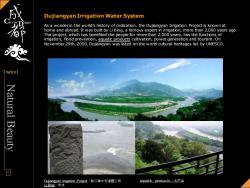
Dujiangyan Irrigation Water System As a wonder in the world's history of civilization,the Dujiangyan Irrigation Project is known at home and abroad.It was built by Li Bing,a famous expert in irrigation,more than 2,000 years ago. The project,which has benefited the people for more than 2,000 years,has the functions of irrigation,flood prevention,aquatic products cultivation,power generation and tourism.On November 29th,2000,Dujiangyan was listed on the world cultural heritages list by UNESCO. 【INDEX】 Natural Beauty Dujiangyan Imigation Project:都江堰水利灌溉工程 aquatic products水产品 i Bing:李冰
[] INDEX Dujiangyan Irrigation Water System As a wonder in the world’s history of civilization, the Dujiangyan Irrigation Project is known at home and abroad. It was built by Li Bing, a famous expert in irrigation, more than 2,000 years ago. The project, which has benefited the people for more than 2,000 years, has the functions of irrigation, flood prevention, aquatic products cultivation, power generation and tourism. On November 29th, 2000, Dujiangyan was listed on the world cultural heritages list by UNESCO. Natural Beauty Dujiangyan Irrigation Project:都江堰水利灌溉工程 Li Bing:李冰 aquatic products : 水产品

Discovering Chengdu Chengdu has been designated by the State Council as one of the first of 24 famous historical cities of China.From the discovery of elights Historical Spots the Qibaodun Ancient City Ruin and the Jinsha Ruins we can infer that thousands of years ago, 名胜古迹 Chengdu was an important residence of the ancient Shu people.Many celebrities in ancient times left their legends and stories here Legends:传说
Discovering Chengdu Chengdu has been designated by the State Council as one of the first of 24 famous historical cities of China. From the discovery of the Qibaodun Ancient City Ruin and the Jinsha Ruins we can infer that thousands of years ago, Chengdu was an important residence of the ancient Shu people. Many celebrities in ancient times left their legends and stories here. Historical Spots 名胜古迹 Legends:传说
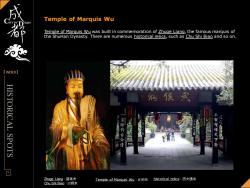
Temple of Marquis Wu Temple of Marquis Wu was built in commemoration of Zhuge Liang,the famous marquis of the ShuHan Dynasty.There are numerous historical relics,such as Chu Shi Biao and so on. 【INDEX】 HISTORICAL SPOTS 焖侯 對古今情 三顧頻煩天下计 Zhuge Liang:诸葛亮 工emple of Marquis Wu:武侯同 historical relics:历史遗迹 Chu Shi Biao:出师表
[] INDEX Temple of Marquis Wu Temple of Marquis Wu was built in commemoration of Zhuge Liang, the famous marquis of the ShuHan Dynasty. There are numerous historical relics, such as Chu Shi Biao and so on. HISTORICAL SPOTS Zhuge Liang:诸葛亮 Chu Shi Biao:出师表 Marquis Temple of Marquis Wu:武侯祠 historical relics: 历史遗迹
按次数下载不扣除下载券;
注册用户24小时内重复下载只扣除一次;
顺序:VIP每日次数-->可用次数-->下载券;
- 《大学英语翻译》课程PPT教学课件(口译)Module 1 Introduction to interpreting course & lead-in.ppt
- 《大学英语翻译》课程PPT教学课件(口译)Module 2-2 sight translation(speed control).ppt
- 《大学英语翻译》课程PPT教学课件(口译)Module 2-1 sight translation(specific skills).ppt
- 《大学英语翻译》课程PPT教学课件(口译)Module 3 memory & summarizing.ppt
- 《大学英语翻译》课程PPT教学课件(口译)Module 4 Escort & liaison interpreting.ppt
- 《大学英语翻译》课程PPT教学课件(口译)Module 2-3 sight translation(C-E).ppt
- 《大学英语翻译》课程PPT教学课件(口译)Module 3 memory, retelling & summarizing.ppt
- 《大学英语翻译》课程PPT教学课件(口译)Module 5 Note-taking(1/2).ppt
- 《大学英语翻译》课程PPT教学课件(口译)Module 5 Consecutive interpreting.ppt
- 《大学英语翻译》课程PPT教学课件(口译)Module 5 Note-taking(2/2).ppt
- 《大学英语翻译》课程PPT教学课件(口译)Module 6 Simultaneous interpreting.ppt
- 《大学英语翻译》课程PPT教学课件(汉译英)第3讲 翻译中的句式衔接与布局.ppt
- 《大学英语翻译》课程PPT教学课件(汉译英)第1讲 汉译英概论.ppt
- 《大学英语翻译》课程PPT教学课件(汉译英)第2讲 翻译中的形合与意合.ppt
- 《大学英语翻译》课程PPT教学课件(汉译英)第4讲 词性转换.ppt
- 《大学英语翻译》课程PPT教学课件(汉译英)第6讲 长句的翻译.ppt
- 《大学英语翻译》课程PPT教学课件(汉译英)第7讲 公示语和翻译中的文化.ppt
- 《大学英语翻译》课程PPT教学课件(汉译英)第5讲 信息结构与翻译.ppt
- 《大学英语翻译》课程PPT教学课件(英译汉)Unit 2 Diction.ppt
- 《大学英语翻译》课程PPT教学课件(英译汉)Unit 4 Omission.ppt
- 《大学英语》课程教学大纲(College English).pdf
- 《大学英语教程》课程教材配套电子教案(PPT教学课件,北大版)第一册 第四单元.pptx
- 《大学英语教程》课程教材配套电子教案(PPT教学课件,北大版)第四册 第八单元.pptx
- 《大学英语教程》课程教材配套电子教案(PPT教学课件,北大版)第一册 第三单元.pptx
- 《大学英语教程》课程教材配套电子教案(PPT教学课件,北大版)第四册 第四单元.pptx
- 《大学英语教程》课程教材配套电子教案(PPT教学课件,北大版)第一册 第二单元.pptx
- 《大学英语教程》课程教材配套电子教案(PPT教学课件,北大版)第三册 第一单元.pptx
- 《大学英语教程》课程教材配套电子教案(PPT教学课件,北大版)第三册 第三单元.pptx
- 《大学英语教程》课程教材配套电子教案(PPT教学课件,北大版)第三册 第二单元.pptx
- 《大学英语教程》课程教材配套电子教案(PPT教学课件,北大版)第三册 第八单元.pptx
- 《大学英语教程》课程教材配套电子教案(PPT教学课件,北大版)第三册 第七单元.pptx
- 《大学英语教程》课程教材配套电子教案(PPT教学课件,北大版)第一册 第一单元.pptx
- 《大学英语教程》课程教材配套电子教案(PPT教学课件,北大版)第四册 第五单元.pptx
- 《大学基础英语》课程教学资源(教学大纲)英语专业四级考试大纲.doc
- 《大学基础英语》课程教学资源(教学大纲)英语专业四级词.doc
- 《大学基础英语》课程教学资源(教学大纲)英语专业四级语法总结.doc
- 《大学基础英语》课程教学资源(试卷习题)2005-2010英语专业四级真题(无答案).doc
- 《大学基础英语》课程教学资源(教学大纲)基础英语一.doc
- 《大学基础英语》课程教学资源(教学大纲)基础英语二.doc
- 《大学基础英语》课程教学资源(教学大纲)基础英语三.doc
